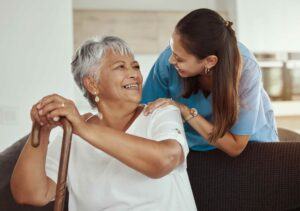Keeping your loved one mobile helps them stay active, reduces their risk of falls, and helps maintain their quality of life. The more mobile they are, the more things they can do and the more independently they can live. However, a lack of mobility and increased risk of falls is a significant risk in older Australians with one in four Australians over the age of 65 having at least one fall a year.1 At Home Care Assistance, we know how falls can impact older adults and how important it is to stay mobile. We have put together this blog on how you can help your older loved one stay mobile and reduce their risk of falls.
As a person ages, physiological changes mean that falls are more likely. However, falls can also lead to injury, hospitalisation, and a loss of mobility, confidence and independence. This can have a significant impact on a person’s life and their ability to live independently. Reducing fall hazards and improving or maintaining mobility can help mitigate and avoid these consequences. You can do many things to help your loved one with this.
- Reduce Hazards in the Home
Removing hazards in the home makes it easier for your loved one to move around safely. Hazards can include items sitting on the floor, rugs or mats with trip edges, uneven surfaces between two rooms, and small or narrow spaces between furniture. If you reduce the things likely to be tripped over, you can reduce the likelihood of falls. This is something that needs to be done repeatedly, not just once. Rugs, for example, might be okay initially but may get scuffed at the edges and become a trip hazard over time.
- Promote Daily Activity
The more your loved one moves around and stands on different surfaces, the more their mobility and strength are maintained. This can include, within their physical capacity, doing tasks within the house, such as cooking a meal, gardening, or moving from one room to another. Even small things like moving from the loungeroom to the kitchen to eat lunch can help. While it is important not to encourage moving that your loved one cannot do safely, the more they move around to the extent they can, the more their mobility is maintained.
- Consider an Exercise Program
Enrolling your loved one in an exercise program for older adults can help build strength and mobility. This helps them be more stable on their feet, so they are mobile. In-person classes have the added advantage of getting them out of the house and allowing them to connect and socialise with other people. If attending an external class is not an option, doing simple exercises at home or taking a class on YouTube can also be beneficial. If your loved one receives home support from a specialist care provider, such as Home Care Assistance, their Care Professional can help them complete their exercise program.
- Encourage the Use of Assistive Devices
While some people may view using assistive devices as a loss of independence, the opposite can be true. Mobility aids such as a cane, or walker can help your loved one move around safely so they can do so for longer. While using mobility aids before they are required can result in a loss of mobility, using them when they are needed helps maintain mobility. Moving around using an assistive device is better than not moving at all. Temporary use of a mobility aid can also help regain mobility following a fall, injury or illness.
- Provide the Right Level of Physical Support
Providing physical support to your loved one if it is unnecessary can reduce mobility. If they can stand up from their chair without help, let them do it even if it takes longer. The more they use their muscles for this type of movement, the more they maintain their strength. It is also essential to ask if your loved one wants help rather than just giving it. While you may view this as being helpful, it takes away control from your loved one. If you think they need assistance, ask them if you can help them and how you can help them. This gives them control but also means the assistance you provide is what they need, not something that may cause other injury.
Maintaining mobility as much as possible is a key part of aging well. By following these steps, you can help your loved one keep or regain their mobility. If your loved one receives hope support from a specialist provider such as Home Care Assistance, their Care Professional can help your loved one maintain their mobility and give ideas on how to support your loved one.
Support at home from a specialist provider, such as Home Care Assistance, can bring enormous benefit and comfort to your quality of life while living independently at home. Home Care Assistance has viable solutions when it comes to supporting independent living. For more information, get in touch with a Home Care Assistance near me today.
As a leading age care provider, Home Care Assistance offers tailored in-home care services for older Australians, enabling them to live happier and healthier lives in the comfort of their own homes.
We offer private and government subsidised Care Packages and have office locations that are a registered NDIS provider. Our Care Workers undergo extensive training in order to deliver unmatched in-home aged care services where people can continue ageing in place. We are proud ambassadors of the My Aged Care government funded aged care program, enabling Australians to successfully navigate the process and gain approval for in-home care support packages. Home Care Assistance offers hourly care, specialised care, Alzheimer’s and Dementia care, hospital to home care, and 24 hour in home care.













